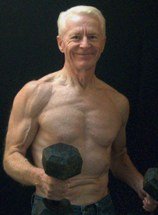| Back to Back Issues Page |
 |
|
The Gray Iron Fitness Newsletter, Issue #293. Peloton vs. Old School. February 15, 2021 |
Hi
February 15, 2021
In this newsletter . . . Peloton vs. Old SchoolAs younger seniors, Patty and I led cardio-kickboxing classes at a local health club. It was great fun, and of course, getting paid while exercising is always better than paying gym dues. We did it for three years or so, and I was pushing age 70 when our series ended. Today those workouts (“butt kickers”) would do me in, for sure. If I could do them at all. Later on, we worked out together for a few years at another health club. We were steady but tapered-off the high-intensity stuff that we were used to while leading the kickboxing classes. It’s what I mean by being age appropriate, as the years pass. Nowadays, Patty rides a fancy Peloton stationary bike and loves it. I’m in my 80s and take daily 40-minute walks with our family dog, Emma. It’s great for Emma, and for me, and nothing tops being outdoors. Patty’s Peloton program also provides resistance work and stretching, as well as cardio bike rides. For my own resistance exercise, I do three days a week of what I call a “senior adaptation” of Tabata. It is the Tabata format of repeating 20-seconds of work followed by 10-seconds of rest. Though my version doesn’t include nearly the high intensity of classic Tabata for younger people. Young seniors, in good shape, can really go all-out with full-on Tabata, or similar HITT workouts, assuming they have no underlying physical limitations. Then as the years add-up, they should be smart about it and adjust the duration and/or intensity. How much duration and how much intensity? My personal rule is that if I’m still tired following a good night’s rest, it usually means overtraining in some way. It is time to adjust. Here is a sample of a typical Tabata routine. Twenty intense seconds of each exercise, followed by 10-seconds rest; then on to the next exercise, 20/10, et cetera. Young seniors: give it an all-out effort. Older folks: keep moving, but ease-up on the intensity.
Once completed, that counts as one Tabata. It takes only four minutes to run through it once. Have fun but ease into it. At any age, don’t go all-out the first time you do it. If you’ve put in a serious effort, you’ll be huffing and puffing. Don’t feel that one Tabata is enough? After a short breather, do another one, or two. Important Notes: 1) Please first read my page on Interval Training. Then at the bottom of the page, access the free online Tabata timer to take the guess-work out of your session. 2) Tabata is not for beginners. Senior beginners should start off with a starter program, before doing Tabata or other HIIT workouts. Stay healthy. Stay fit. Logan Are you on Facebook?Check out the Senior Exercise Central page at . . . https://www.facebook.com/GrayIronFitness
I search the Internet for senior health and fitness items. If you like what you see, please click the Like button. It helps me. Spread the word. If you like the newsletter, we're making it easy to share it Newsletter Policy The Gray Iron Fitness Newsletter is a free publication sent twice monthly to subscribers. The purpose is to provide honest and realistic fitness information for people age 50 and above. I have never been paid or received compensation of any kind to write a positive review or endorse a product. If I say that I personally use a product or service, it is because I find value in it and have paid for it with my own money. Like newspapers, magazines and television, this newsletter and my web site contain advertising and marketing links. Naturally, I am compensated for these. The newsletter and web site provide information to help users establish and maintain a fitness lifestyle. But fitness information is not the same as fitness advice, which is the application of exercise and dietary practices to an individual's specific circumstances. Therefore, always consult with your physician for assurance that fitness information, and your interpretation of it, is appropriate for you. Your comments and questions are always appreciated. Simply click on the "Reply" bottom. |
| Back to Back Issues Page |